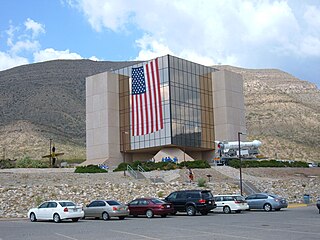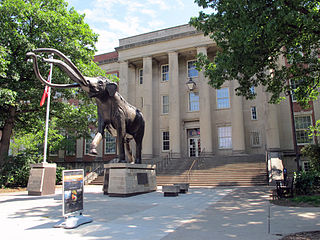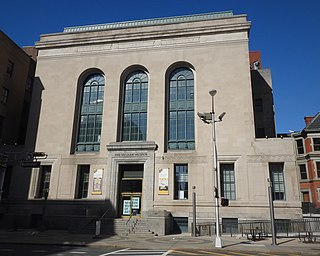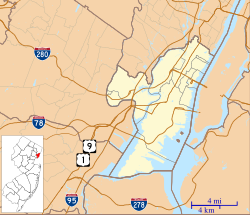
The New Mexico Museum of Space History is a museum and planetarium complex in Alamogordo, New Mexico, United States, dedicated to artifacts and displays related to space flight and the Space Age. It includes the International Space Hall of Fame. The Museum of Space History highlights the role that New Mexico has had in the U. S. space program, and is one of eight museums administered by the New Mexico Department of Cultural Affairs. The museum has been accredited by American Alliance of Museums since 1993. The museum is also a Smithsonian Affiliate.
The Oregon Museum of Science and Industry is a science and technology museum in Portland, Oregon, United States. It contains three auditoriums, including a large-screen theatre, planetarium, and exhibition halls with a variety of hands-on permanent exhibits focused on natural sciences, industry, and technology. Transient exhibits span a wider range of disciplines.

Ernő Rubik is a Hungarian inventor, widely known for creating the Rubik's Cube (1974), Rubik's Magic, Rubik's Magic: Master Edition, and Rubik's Snake.

The University of Nebraska State Museum, also known as Morrill Hall, founded in 1871, is a natural history museum featuring Nebraska biodiversity, paleontology, and cultural diversity, located on the University of Nebraska–Lincoln City Campus near the corner of 14th and Vine Streets in Lincoln, Nebraska, United States. The museum houses Mueller Planetarium, a hands-on science discovery center, and the Elephant Hall, where visitors can see the world's largest articulated fossil mammoth among the collection of fossil elephants. Also featured are interactive paleontology exhibits, a dinosaur gallery, ancient life and evolution exhibits, wildlife dioramas, gems and minerals, American Indian and African exhibits, and a temporary exhibit gallery featuring rotating displays on diverse topics including photography, quilts and fine arts.

The South Carolina State Museum is a museum dedicated to the history of South Carolina. It has four floors of permanent and changing exhibits, a digital dome planetarium, 4D interactive theater, and an observatory. The State Museum is located along the banks of the Congaree River in downtown Columbia, South Carolina. It is the largest museum in the state, and is a Smithsonian Affiliate and part of the American Alliance of Museums. Positioned on an old shipping canal that dates back to pre-Civil War times, the museum is widely recognized as a resource for South Carolina history and lifestyle.

The Newark Museum of Art, formerly known as the Newark Museum, in Newark, Essex County, New Jersey is the state's largest museum. It holds major collections of American art, decorative arts, contemporary art, and arts of Asia, Africa, the Americas, and the ancient world. Its extensive collections of American art include works by Hiram Powers, Thomas Cole, John Singer Sargent, Albert Bierstadt, Frederick Church, Childe Hassam, Mary Cassatt, Edward Hopper, Georgia O'Keeffe, Joseph Stella, Tony Smith and Frank Stella.

The Museum of Science (MoS) is a nature and science museum and indoor zoological establishment located in Science Park, a plot of land in Boston and Cambridge, Massachusetts, spanning the Charles River. Along with over 700 interactive exhibits, the museum features a number of live and interactive presentations throughout the building each day, along with scheduled film showings at the Charles Hayden Planetarium and the Mugar Omni Theater.

The Science Museum of Minnesota is a museum in Saint Paul, Minnesota, focused on topics in technology, natural history, physical science, and mathematics education. Founded in 1907, the 501(c)(3) nonprofit institution has 385 employees and is supported by volunteers.

Chuck Hoberman is an artist, engineer, architect, and inventor of folding toys and structures, most notably the Hoberman sphere.

The Saint Louis Science Center, founded as a planetarium in 1963, is a collection of buildings including a science museum and planetarium in St. Louis, Missouri, on the southeastern corner of Forest Park. With over 750 exhibits in a complex of over 300,000 square feet (28,000 m2), it is among the largest of its type in the United States.

Paul Hoffman is the president and CEO of the Liberty Science Center in Jersey City, New Jersey. He is also a prominent author, science educator, food entrepreneur, Moth storyteller, and host of the PBS television series Great Minds of Science.

COSI, officially the Center of Science and Industry, is a science museum and research center in Columbus, Ohio. COSI was opened to the public on 29 March 1964 and remained there for 35 years. In 1999, COSI was moved to a 30000 m2 facility, designed by Japanese architect Arata Isozaki along a bend in the Scioto River in the Franklinton neighborhood. COSI features more than 300 interactive exhibits throughout themed exhibition areas.

The Evansville Museum of Arts, History & Science is a general-interest museum located on the Ohio riverfront in downtown Evansville, Indiana, United States. Founded in 1904, it is one of Southern Indiana's most established and significant cultural institutions, with comprehensive collections in art, history, anthropology and science. It has a permanent collection of over 30,000 objects including fine arts, decorative arts, historic documents and photographs, and anthropologic and natural history artifacts. Also on the museum's campus is the Evansville Museum Transportation Center, featuring Southern Indiana transportation artifacts from the late 19th through the mid-20th centuries. The museum is accredited by the American Alliance of Museums.

The Cox Science Center and Aquarium, formerly the South Florida Science Center and Aquarium, is a science museum located in West Palm Beach, Florida. Founded in 1959, the goal of the organization is to open every mind to science through the strategic programming of interactive exhibits and engaging community-based camps and events. The Cox Center has expanded since its creation and now houses over 50 hands-on exhibits, a planetarium, a 3000 square foot aquarium, a miniature golf course, and a large exhibit space that displays a temporary travelling exhibit. The Cox Center is a member of the Association of Science-Technology Centers program, which offers a membership that is redeemable at other ASTC science and technology centers around the world. The Cox Center occupies Dreher Park alongside the Palm Beach Zoo and offers deals for entrance into both facilities.

The New Jersey State Museum is located at 195-205 West State Street in Trenton, in the U.S. state of New Jersey. The museum's collections include natural history specimens, archaeological and ethnographic artifacts, and cultural history and fine art objects. Exhibitions, educational activities, research programs, and lectures are also offered. The museum, a division of the New Jersey Department of State, includes a 140-seat planetarium and a 384-seat auditorium.

The Western Science Center (WSC), formerly the Western Center for Archaeology & Paleontology, is a museum located near Diamond Valley Lake in Hemet, California. The WSC is home to a large collection of Native American artifacts and Ice Age fossils that were unearthed at Diamond Valley Lake, including "Max", the largest mastodon found in the western United States, and "Xena", a Columbian mammoth, as well as dinosaur fossils recovered from New Mexico.

Science City, Kolkata is a science centre and science park in Kolkata, West Bengal, India. It is currently the largest science centre in the Indian subcontinent, containing a science museum, science park, and auditoriums. The centre was inaugurated in two parts, with the ‘Convention Centre Complex’ being the first on December 21, 1996, followed by the rest on July 1, 1997, by the then-prime-minister Inder Kumar Gujral. On January 10, 2010, the then-prime-minister of India, Manmohan Singh, would attempt to get the second phase of Science City completed.
Anthony Michael Brooks is an American speed cubing champion. He specializes in the 2x2 cube and classic 3x3 cube, and used to be officially ranked in the top five in the world in both categories as recognized by the World Cube Association. Since learning to solve the cube in March 2008, Brooks has become known for developing advanced speedsolving methods as well as frequently promoting speedcubing in the media. While working as the Liberty Science Center's Speedcuber-in-Residence, Brooks set the Guinness World Record for most Rubik's Cubes solved underwater in a single breath, and also led the team that currently holds the world record for solving the Groovik's Cube, the world's largest functioning Rubik's Cube. In July 2017, Brooks was featured on the debut season of FOX's Superhuman TV show.
The Herrett Center for Arts and Science, located on the main campus of the College of Southern Idaho in Twin Falls, Idaho, United States, is a museum of anthropology, natural history, astronomy, and art. The museum's collections primarily comprise anthropological artifacts and natural history specimens from the Americas, as well as works of local artists. The Center also houses the Faulkner Planetarium, the Centennial Observatory, a museum store, and a 2900 square foot multi-purpose event space.

The Museum of Idaho (MOI) is a history and science museum in downtown Idaho Falls, Idaho. The museum features exhibits, collections, and programs focused on the social and environmental history of Idaho and the Intermountain West, as well as prominent traveling exhibits on a variety of subjects. Its tagline is “bringing the world to Idaho, and Idaho to the world”.






















